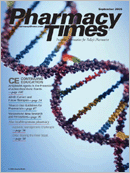Publication
Article
Pharmacy Times
A Pharmacist's Guide to OTC Therapy: Homeopathic Cold Products
Author(s):
For any individual suffering with the discomfort due to the symptoms associated with the common cold, relief from these symptoms is a top priority. It is estimated that 1 billion cases of the common cold are reported in the United States annually.1 Cold season in the United States typically ranges from late August through early April. Pharmacists can be a key source of information for consumers seeking advice on cold product selections, including both the traditional OTC cold preparations and homeopathic cold preparations. Echinacea, high-dose vitamin C, and zinc are commonly used by many individuals for the treatment of the common cold (Table).
Echinacea
Estimates from the Centers for Disease Control and Prevention state that echinacea is the most commonly used herb in the United States.1 Echinacea is available in various formulations as single-entity or combination forms that include capsules, teas, and hydroalcoholic extracts. While there is no evidence to indicate that echinacea is effective in preventing colds, there is evidence which shows that the use of it can significantly reduce both the severity and duration of the common cold.1
Pharmacists should advise consumers that echinacea is contraindicated in women who are pregnant or breastfeeding and should not be administered to children younger than 2 years of age. It also is contraindicated in individuals with medical conditions such as multiple sclerosis, HIV/AIDS, leukemia, or other autoimmune disorders. Typically, echinacea is well-tolerated among the general patient population but should not be taken for >8 consecutive weeks.1,2 The most commonly reported adverse effects include dyspepsia, headache, and dizziness.
Vitamin C
While the use of vitamin C does not decrease the number of colds an individual may have, studies have shown that large doses of vitamin C (>1 g/day) started early in the course of the common cold may decrease the duration of the cold slightly (<1 day) and may decrease the severity of the cold by approximately 20%.1 There is still great debate among health care professionals regarding the health benefits versus the health risks of using high doses of vitamin C.1 It is imperative that pharmacists inform their patients about the potential adverse effects associated with the routine use of high doses of vitamin C, which can include diarrhea, increased iron absorption, kidney stones, nausea, abdominal cramping, and flatulence.
Zinc
Zinc is commonly used by many patients with colds. High local concentrations of zinc ions purportedly block the adhesion of the human rhinovirus to the nasal epithelium.1 Zinc is available in a variety of formulations, such as tablets, capsules, lozenges, chewing gums, nasal sprays, gels, and swabs. Prior to taking zinc, patients should consult with their physicians, especially those taking angiotensin-converting enzyme inhibitors, nonsteroidal anti-inflammatory drugs, immunosuppressant agents, certain antibiotics such as oral quinolones and tetracyclines, and hormone replacement therapy agents.3 The common side effects associated with the use of zinc include gastrointestinal effects such as nausea, vomiting, and dysgeusia (a metallic taste in the mouth).
Patient Counseling
In addition to providing information to patients about these alternative therapies for the common cold, pharmacists can remind patients about the means of transmission and prevention of colds.As with all medications, pharmacists should encourage their patients to discuss the use of any of these alternative therapies with their physicians prior to using them.
Ms. Terrie is a clinical pharmacy writer based in Haymarket, Va.
For a list of references, send a stamped, self-addressed envelope to: References Department, Attn. A. Rybovic, Pharmacy Times, Ascend Media Healthcare, 103 College Road East, Princeton, NJ 08540; or send an e-mail request to: [email protected]







